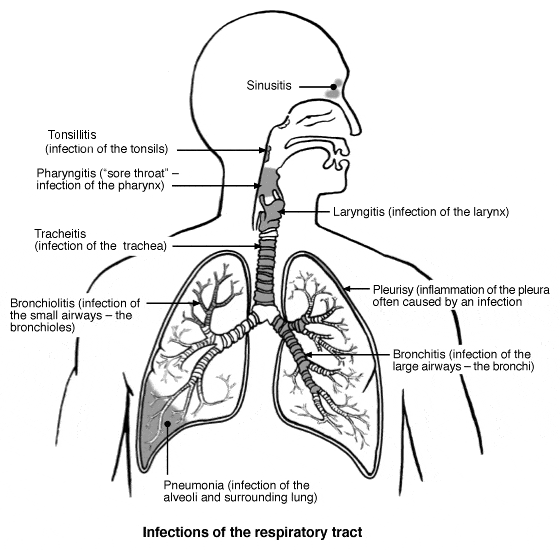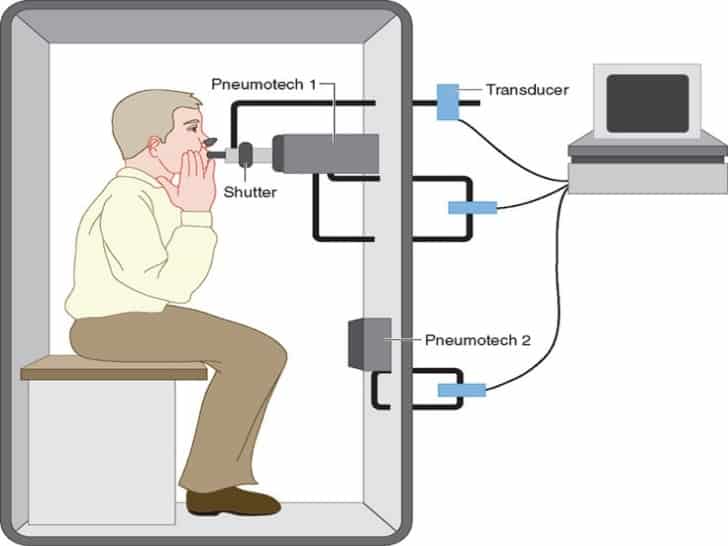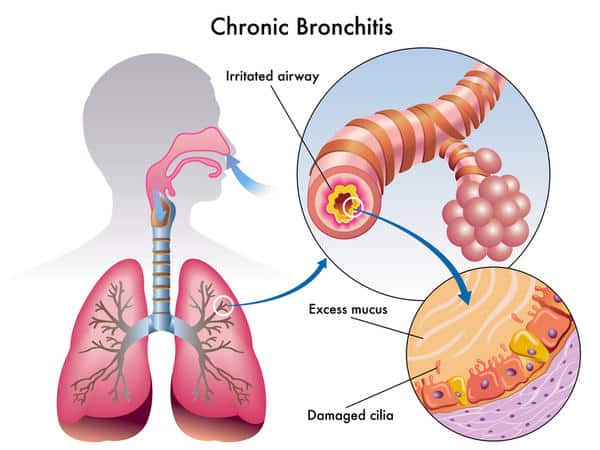Allergy to almost all the foods triggered my severe bronchitis
She had been suffering from severe bronchitis for 6 weeks when she came to our office. She was found to be allergic to almost all the foods she was tested for through NTT, especially whole wheat, oat bran, bran flakes, etc. She was treated for all the known food allergies first and placed on a diet of only non-allergic foods.
In less than two weeks, her bronchitis got better, as well as the cough, and her energy levels picked up. She was on disability leave when she came to our office. Three and a half months later she was working full-time.
Bronchitis on the rise in UAE
Changing weather conditions in the past few months have resulted in diverse medical conditions such as bronchitis, upper respiratory infections (URI), rheumatism, allergies, and asthma.
(Source: Gulf News, Published: 22:32 April 10, 2009, By Dina El Shammaa, Staff Reporter)
Most of these conditions have risen to over 40 percent among patients aged 13 to 35 in the past four months, especially acute bronchitis which may result in a more serious health problem such as asthma or chronic bronchitis which weather experts believe can be caused from pollen.
What is Bronchitis?
It is an inflammation of the lining of the bronchial tubes, the airways that connect the trachea (windpipe) to the lungs. This delicate, mucus-producing lining covers and protects the respiratory system (the organs and tissues involved in breathing). Bronchitis is divided into two types: acute and chronic. Acute bronchitis is also known as a chest cold.
Acute Bronchitis
Acute bronchitis is the sudden development of inflammation in bronchial tubes the major airways into your lungs. It usually happens because of a virus or breathing in things that irritate the lungs such as tobacco smoke, fumes, dust, and air pollution. Bacteria sometimes cause acute bronchitis.

The diagram above shows the sites of a range of respiratory infections. This image just deals with acute bronchitis.
How does acute bronchitis affect the body?
In acute bronchitis, cells that line the bronchi become infected. The infection usually starts in the nose or throat and travels to the bronchial tubes. When the body tries to fight the infection, it causes the bronchial tubes to swell. This causes you to cough. Sometimes it is a dry cough, but often you will cough up mucus (sputum).
The inflammation also causes less air to be able to move through the bronchial tubes, which can cause wheezing, chest tightness and shortness of breath. Eventually, the immune system fights off the infection.
Acute bronchitis usually lasts for 3-10 days. However, your cough and mucus (sputum) production can last for several weeks after the infection has cleared.
What are the symptoms of Acute Bronchitis?
The symptoms of acute bronchitis aren’t specific. They mimic symptoms of other conditions, such as:
- chronic cough
- chronic bronchitis
- postnasal drip
- pneumonia
Therefore, acute bronchitis must always be diagnosed by a doctor.
Symptoms of acute bronchitis include:
- a cough, which may continue beyond 10 days and contain clear or colored mucus
- shortness of breath
- wheezing
- a low-grade fever or a high fever may be an indication of a secondary infection such as pneumonia
- chest pain
- chest tightness
- a sore throat from persistent coughing
Children with acute bronchitis may experience:
- a runny nose
- chills
- back pain
- muscle pain
- a sore throat
What causes Acute Bronchitis?
Acute bronchitis is usually caused by a virus. Often a person gets acute bronchitis a few days after having an upper respiratory tract infection such as a cold or the flu. Sometimes acute bronchitis is caused by bacteria.
Acute bronchitis also can be caused by breathing in things that irritate the bronchial tubes, such as smoke. It also can happen if a person inhales certain foods.
How is Acute Bronchitis tested and diagnosed?
During the first few days of illness, it can be difficult to distinguish the signs and symptoms of bronchitis from those of a common cold. During the physical exam, your doctor will use a stethoscope to listen closely to your lungs as you breathe.
In some cases, your doctor may suggest:
- Chest X-ray. A chest X-ray can help determine if you have pneumonia or another condition that may explain your cough. This is especially important if you ever were or currently are a smoker.
- Sputum tests. Sputum is the mucus that you cough up from your lungs. It can be tested to see if you have whooping cough (pertussis) or other illnesses that could be helped by antibiotics. Sputum can also be tested for signs of allergies.

Pulmonary function test. During a pulmonary function test, you blow into a device called a spirometer, which measures how much air your lungs can hold and how quickly you can get air out of your lungs. This test checks for signs of asthma or emphysema.
How is Acute Bronchitis treated?
Adults may take aspirin, acetaminophen, or ibuprofen to reduce fever and general feelings of illness, but children should take only acetaminophen or ibuprofen, not aspirin because children taking aspirin are at higher risk for Ryes syndrome. People with acute bronchitis, especially those who have a fever, should drink plenty of fluid.
In children, very mild symptoms of limited airflow can be helped with cool-mist humidifiers or steam vaporizers. In more severely affected children and adults who are wheezing, inhaled bronchodilators, which widen the bronchi, can be used to open the airways and reduce wheezing.
Cough medicines can be used to suppress a dry, disturbing cough, particularly when it interferes with sleep. However, the degree of effectiveness of these drugs is not clear.
Also, a cough that produces a lot of sputum usually should not be suppressed. Expectorants may help to thin secretions and make them easier to cough up, but whether this measure is helpful is not clear.
NOTE: Do not take any medication without consulting your doctor.
Chronic Bronchitis
Chronic bronchitis is one type of COPD (chronic obstructive pulmonary disease). The inflamed bronchial tubes produce a lot of mucus. This leads to coughing and difficulty breathing. Cigarette smoking is the most common cause. Breathing in air pollution, fumes, or dust over a long period of time may also cause it.

How does chronic bronchitis affect the body?
Chronic bronchitis affects the bronchial tubes, which bring air to your lungs. It is caused by a long period of smoking or inhaling other types of irritants. When you have bronchitis, the glands in your bronchial tubes inflame and begin to release more mucus than usual. The swelling restricts airflow, making it more difficult to breathe.
After a while, constant inflammation takes a toll on your bronchial tubes, causing the glands to scar and create permanent damage to the lining of the tubes. Bronchitis is said to be chronic when it goes on for most days of the month for three months for two or more consecutive years, with no other underlying cause.
What are the symptoms of Chronic Bronchitis?
- Cough is the most common symptom of chronic bronchitis. The cough may be dry or it may produce phlegm. Significant phlegm production suggests that the lower respiratory tract and the lung itself may be infected, symptoms which may also be concerning for pneumonia.
- The cough in chronic bronchitis persists for most days of the month, for at least three months, and at least two years in a row.
- Continued forceful coughing from chronic bronchitis may be painful and can make your chest and abdominal muscles sore. Coughing can be severe enough at times to injure the chest wall, break ribs or even cause a person to pass out (faint).
- During exacerbations (periods where the condition worsens) of chronic bronchitis, wheezing may occur because of the muscular tightness and inflammation of the airways. This may leave the affected individual short of breath.
- Asthmatic bronchitis symptoms include a combination of wheezing and shortness of breath, in addition to the other symptoms of chronic bronchitis.
What causes Chronic Bronchitis?
There can be many causes of chronic bronchitis, but the main cause is cigarette smoke. Statistics from the US Centers for Disease Control and Prevention (CDC) suggest that about 49% of smokers develop chronic bronchitis and 24% develop emphysema/COPD.
Many other inhaled irritants (for example, smog, industrial pollutants, and solvents) can also result in chronic bronchitis.
Viral and bacterial infections that result in acute bronchitis may lead to chronic bronchitis if people have repeated bouts with infectious agents.
Also, underlying disease processes (for example, asthma, cystic fibrosis, immunodeficiency, congestive heart failure, familial genetic predisposition to bronchitis, and congenital or acquired dilation of the bronchioles, known as bronchiectasis) may cause chronic bronchitis to develop, but these are infrequent causes compared to cigarette smoking.
How is Chronic Bronchitis tested and diagnosed?
In making a diagnosis of chronic bronchitis, your doctor will begin by conducting a thorough physical examination, recording your medical history and asking about any symptoms you are experiencing.
The following tests may then be conducted to make a definite diagnosis:
- Pulmonary Function Testing (PFT). This test involves a series of breathing maneuvers that measure the airflow and volume of air in your lungs. This allows your doctor to objectively assess the function of your lungs.
- High-Resolution Computed Tomography (HRCT). This is a special type of CT scan that provides your doctor with high-resolution images of your lungs. Having an HRCT is no different than having a regular CT scan; they both are performed on an open-air table and take only a few minutes.
- Chest X-Ray. Chest X-rays can help confirm a diagnosis of chronic bronchitis and rule out other lung conditions.
- Sputum Examination. Analysis of cells in your sputum can help determine the cause of some lung problems.
How is Chronic Bronchitis treated?
The goal of therapy for chronic bronchitis is to relieve symptoms, prevent complications and slow the progression of the disease. Quitting smoking is also essential for patients with chronic bronchitis since continuing to use tobacco will only further damage the lungs.
Treatment may include:
- Bronchodilator Medications — Inhaled as aerosol sprays or taken orally, bronchodilator medications may help to relieve symptoms of chronic bronchitis by relaxing and opening the air passages in the lungs.
- Steroids — Inhaled as an aerosol spray, steroids can help relieve symptoms of chronic bronchitis. Over time, however, inhaled steroids can cause side effects, such as weakened bones, high blood pressure, diabetes, and cataracts. It is important to discuss these side effects with your doctor before using steroids.
- Antibiotics — Antibiotics may be used to help fight respiratory infections common in people with chronic bronchitis.
- Vaccines — Patients with chronic bronchitis should receive a flu shot annually and pneumonia shot every five to seven years to prevent infections.
- Oxygen Therapy — As a patient’s disease progresses, they may find it increasingly difficult to breathe on their own and may require supplemental oxygen. Oxygen comes in various forms and may be delivered with different devices, including those you can use at home.
- Surgery — Lung volume reduction surgery, during which small wedges of damaged lung tissue are removed, may be recommended for some patients with chronic bronchitis.
- Pulmonary Rehabilitation — An important part of chronic bronchitis treatment is pulmonary rehabilitation, which includes education, nutrition counseling, learning special breathing techniques, help with quitting smoking and starting an exercise regimen. Because people with chronic bronchitis are often physically limited, they may avoid any kind of physical activity. However, regular physical activity can actually improve a patient’s health and wellbeing.NOTE: Do not take any medication without consulting your doctor.
How we treat BRONCHITIS
With us, we get to the root of the problem, identifying and eliminating the allergen that is causing the recurring symptoms.
We offer the prospect of relief to those who suffer from addiction and allergies by reprogramming the brain to perfect health. Just like rebooting a computer, we can reboot our nervous system to overcome the adverse reactions of brain and body.
To fully understand what we do, one needs to know some Oriental medical principles. We take the acupuncture and Oriental medical theories and developed a technique that can eliminate the reaction from the root.
Addictions can definitely cause illness. Continuous contact with an allergen produces toxins in the body and causes blockages in the meridians. If these blockages are not cleared, reactions to the allergens often produce symptoms that mimic other diseases.

By clearing food and environmental allergens from the protocol, we strengthen the immune system, improve digestion and absorption. This allows the body to get the necessary nutrients, which are essential for life.
One allergen is cleared per visit. Each individual has a different genetic makeup and health history so the number of sessions required varies from one individual to another. For some people, allergens are cleared immediately however, for others it may take many sessions to accomplish the desired results.
Some people might raise their eyebrows and ask, “Can you really eliminate my Bronchitis?” We answer with a resounding “YES!”
NAET Treatment- Resolved Bronchitis
“Ray a man of 44, responded well to the treatment for the energy of diphtheria, thus clearing his chronic bronchitis. He had inherited the tendency toward allergies from his mother, who almost died from diphtheria when she was seven. The reaction to diphtheria was manifested in him as bronchitis, sinusitis, and arthritis.”
“A 34-year-old female suffered from chronic bronchitis for over a year. When she came to me for evaluation, she had gone through many courses of antibiotics, was on oxygen support, and leading a miserable life. In this case, NMST detected fabric softener as the causative agent. She had changed the fabric softener just over a year before and continued to use that one ever since.
When we identified the source, I encouraged her to stop using all fabric softeners for a while instead of treating the fabric softener with NAET. We wanted to see how soon she became free from symptoms when avoiding the allergen. To remove the softener residue, we asked her to double rinse all the fabrics in the house including her clothes, washcloths, bath towels, bed linen, sofa cover, etc. She was also asked to air out her house by opening windows and doors letting the air take away the smell left from fabric softener. She moved out of the house for a few days.
After a week, when she returned to the office for treatment, her bronchitis was almost gone. Then she was desensitized for the fabric softener with NAET. After that, she was free from her bronchitis. Even though the allergy was gone, she was too fearful to use the same fabric softener again. She said, “The painful memories of the past year were enough to last a lifetime!”
Connect with us through our Facebook page at www.facebook.com/NAETDubai or visit: www.naetdubai.com. You will find a wealth of information here along with an opportunity to speak confidentially through WhatsApp 056-639 0197 or Phone Call 04-420 1633.
You may also email us at admin@naetdubai.com





12 Responses
This is a Great post. All the information about Chronic and acute bronchitis is explained very well.
That’s a great post! I really liked reading it.
Thank you so much 🙂 . Please don’t forget to subscribe to our blog and you will receive mails once we published new blogs.
Hi, thank you for your comment. We are looking forward to hearing from you on our next blogs. Please don’t forget to subscribe to our blog and you will receive mails once we published new blogs.
Thank you for your comment 🙂
Hi, thank you for your comment ???? We are looking forward to hearing from you on our next blogs. Please don’t forget to subscribe to our blog and you will receive mails once we published new blogs.
Thank you for your comment 🙂
Thank you for your comment 🙂
Thank you 🙂 . Please don’t forget to subscribe to our blog and you will receive mails once we published new blogs.
I’m also writing to let you understand what a nice encounter our girl had checking your site. She figured out too many things, including what it’s like to have an ideal giving mindset to make other folks with ease learn specific hard to do subject areas. You really surpassed visitors’ desires. Many thanks for presenting those precious, healthy, edifying and as well as unique tips about your topic to Emily.
Just wanna remark that you have a very nice web site , I enjoy the design it really stands out.
This is a great blog.